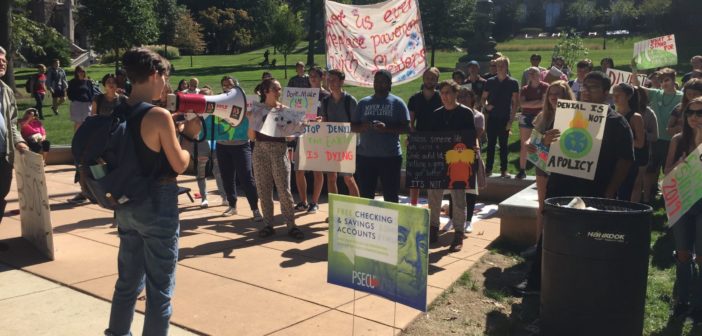A megaphone cracked over the quiet front lawn. It emanated from the crowd gathered at the base of the University Center flag pole, drowning out scheduled PSECU, Pennsylvania States Employees Credit Union, tabling. Above, the American flag flew at full staff in a cloudless sky, but below, a blur of faces and voices signaled distress. The faces grimaced, nodded and shouted in agreement with the megaphone’s squawk.
“Climate strike, save the planet” the group said to those who idly filtered past. Humidity and glaring sun beset the late September air, a reminder of the enemy the group had assembled to face. Some strikers held signs cocked at their waists, ready to be raised at a moment’s notice. Others held textbooks, walking straight from their classes to the 1 p.m rally. All came to join millions around the globe marching to protest the global climate crisis on Friday, Sept. 20.
Footsteps clopped across cobblestone town squares and squeaked around linoleum floors of public spaces around the world. Protestors halted gas-guzzling cars by filling avenues and streets, finally standing in solidarity against climate change and its threat to humanity.
Sensing a need, Tori Campbell, ‘20, and Becca Salsburg-Frank, ‘19, began rallying their friends for the climate strike less than a week prior to Sept. 20.
“Lehigh has millions of dollars in resources,” Campbell said. “If we’re students here for a short period of time, it’s our responsibility to take advantage of these resources as best we can to help the community.”
Campbell’s and Salsburg-Frank set plans in motion quickly. They spent a week exhausting their printing dollars on fliers to distribute across campus and in student group chats. “Strike like a 16-year-old,” their flier read, framed with eight different languages.
At the flag pole rally, a revolving door of student and advocate speakers quelled the crowd into attentive silence before thrusting them into unified uproar.
“Stand up, fight back,” they said as one.
As Vice Provost Patrick Farrell passed the flag pole, he was urged to take the megaphone to share Lehigh’s response to the climate crisis.
“This is a great place to begin…so I appreciate your interest. Find out how you can participate (in) campus sustainability efforts. There are quite a few. Find out how you can participate in Bethlehem and around the neighborhood,” Farrell said to the gathering.
Thirty minutes had passed since the megaphone’s first burst when it admonished the crowd toward Bethlehem’s city hall. There, they would meet other strikers from the surrounding Bethlehem community in a larger strike organized by Northampton Community College’s Climate Action Network.
People flooded down the University’s main walkway, occasional chants were the river’s roaring rapids and bystanding students parted the way when the deluge approached.
“We’re people, united,” they chanted. “We’ll never be divided.”
Strikers walked a 5,000-foot straight on Bethlehem’s New Street and over the Phillip J. Fahy bridge that joins South and North Bethlehem. Cars honked and heckled the marchers, but their backs were to the sun and their eyes were locked forward.
Jim and Debra Orben, ‘72 and ‘76G, marched from Lehigh’s flagpole to city hall. When Jim Orben was a Lehigh undergraduate, he led demonstrations against the Vietnam war. On Sept. 20, however, he and his wife demanded responsible environmental policy.
“It’d be a very good model for a university of Lehigh’s stature to let the world know, to let all of its students and graduates know (that) fossil fuels are soon to be a thing of the past,” Jim Orben said.
Lehigh has received scrutiny for its investments in fossil fuel and natural gas industries.
“We need to transition from the archaic fossil fuels to renewable (energy),” Debra Orben said.
The South Side marchers spilled out onto the concrete delta of the Fahy bridge’s northern end, rounded a tree-lined bend and poured into the area outside Bethlehem’s town hall. They were greeted by a who’s-who gala of local environmentalism. Scientists, educators, researchers, news reporters, farmers, politicians, religious figures and activists of all ages dotted the pavement. Larger organizations, such as the Sierra Club, tabled at the fringes.
Ron Harley, a Lehigh Valley resident and activist, stood by the intersection of West Church Street and North New Street to endorse civilian protest.
“Europe has gotten everything that they’ve gotten cause of people were taking to the streets,” Harley said. “People (need to) realize that they have the power, not the big millionaires, but the average person has the power, strength and numbers willing to get out into the streets and all.”






Comment policy
Comments posted to The Brown and White website are reviewed by a moderator before being approved. Incendiary speech or harassing language, including comments targeted at individuals, may be deemed unacceptable and not published. Spam and other soliciting will also be declined.
The Brown and White also reserves the right to not publish entirely anonymous comments.